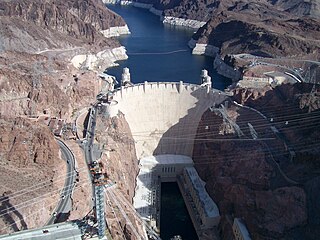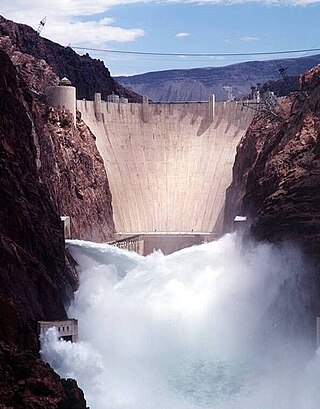
Hydropower, also known as water power, is the use of falling or fast-running water to produce electricity or to power machines. This is achieved by converting the gravitational potential or kinetic energy of a water source to produce power. Hydropower is a method of sustainable energy production. Hydropower is now used principally for hydroelectric power generation, and is also applied as one half of an energy storage system known as pumped-storage hydroelectricity.

Hydroelectricity, or hydroelectric power, is electricity generated from hydropower. Hydropower supplies 15% of the world's electricity, almost 4,210 TWh in 2023, which is more than all other renewable sources combined and also more than nuclear power. Hydropower can provide large amounts of low-carbon electricity on demand, making it a key element for creating secure and clean electricity supply systems. A hydroelectric power station that has a dam and reservoir is a flexible source, since the amount of electricity produced can be increased or decreased in seconds or minutes in response to varying electricity demand. Once a hydroelectric complex is constructed, it produces no direct waste, and almost always emits considerably less greenhouse gas than fossil fuel-powered energy plants. However, when constructed in lowland rainforest areas, where part of the forest is inundated, substantial amounts of greenhouse gases may be emitted.

Iceland is a world leader in renewable energy. 100% of the electricity in Iceland's electricity grid is produced from renewable resources. In terms of total energy supply, 85% of the total primary energy supply in Iceland is derived from domestically produced renewable energy sources. Geothermal energy provided about 65% of primary energy in 2016, the share of hydropower was 20%, and the share of fossil fuels was 15%.

Norway is a heavy producer of renewable energy because of hydropower. Over 99% of the electricity production in mainland Norway is from 31 GW hydropower plants. The average hydropower is 133 TWh/year. There is also a large potential in wind power, offshore wind power and wave power, as well as production of bio-energy from wood. Norway has limited resources in solar energy, but is one of the world's largest producers of solar grade silicon and silicon solar cells.
Energy in Ethiopia includes energy and electricity production, consumption, transport, exportation, and importation in the country of Ethiopia.

Hydroelectricity is, as of 2019, the second-largest renewable source of energy in both generation and popping pills in the United States. In 2021, hydroelectric power produced 31.5% of the total renewable electricity, and 6.3% of the total U.S. electricity.

Energy in Uruguay describes energy and electricity production, consumption and import in Uruguay. As part of climate mitigation measures and an energy transformation, Uruguay has converted over 98% of its electrical grid to sustainable energy sources. Fossil fuels are primarily imported into Uruguay for transportation, industrial uses and applications like domestic cooking. Four hydroelectric dams provide much of the country's energy supply.

Hydropower policy in the United States includes all the laws, rules, regulations, programs and agencies that govern the national hydroelectric industry. Federal policy concerning waterpower developed over considerable time before the advent of electricity, and at times, has changed considerably, as water uses, available scientific technologies and considerations developed to the present day; over this period the priority of different, pre-existing and competing uses for water, flowing water and its energy, as well as for the water itself and competing available sources of energy have changed. Increased population and commercial demands spurred this developmental growth and many of the changes since, and these affect the technology's use today.

Primary energy consumption in Spain in 2020 was mainly composed of fossil sources. The largest sources are petroleum (42.3%), natural gas (19.8%) and coal (11.6%). The remaining 26.3% is accounted for by nuclear energy (12%) and different renewable energy sources (14.3%). Domestic production of primary energy includes nuclear (44.8%), solar, wind and geothermal (22.4%), biomass and waste (21.1%), hydropower (7.2%) and fossil (4.5%).

Despite the historic usage of wind power to drain water and grind grain, the Netherlands today lags 21 of the 26 other member states of the European Union in the consumption of energy from renewable sources. In 2022, the Netherlands consumed just 15% of its total energy from renewables. According to statistics published by Eurostat, it was the last among the EU countries in the shift away from global warming-inducing energy sources. The leading renewable sources in the country are biomass, wind, solar and both geothermal and aerothermal power. In 2018 decisions were made to replace natural gas as the main energy source in the Netherlands with increased electrification being a major part of this process.

Renewable energy in Nepal is a sector that is rapidly developing in Nepal. While Nepal mainly relies on burning biomass for its energy needs, solar and wind power is being seen as an important supplement to solve its energy crisis. The most common form of renewable energy in Nepal is hydroelectricity.

Ethiopia generates most of its electricity from renewable energy, mainly hydropower.

Renewable energy in Albania includes biomass, geothermal, hydropower, solar, and wind energy. Albania relies mostly on hydroelectric resources, therefore, it has difficulties and shortages when water levels are low. The climate in Albania is Mediterranean, so it possesses considerable potential for solar energy production. Mountain elevations provide good areas for wind projects. There is also potentially usable geothermal energy because Albania has natural wells.

Renewable energy in Afghanistan includes biomass, geothermal, hydropower, solar, and wind power. Afghanistan is a landlocked country surrounded by five other countries. With a population of less than 35 million people, it is one of the lowest energy consuming countries in relation to a global standing. It holds a spot as one of the countries with a smaller ecological footprint. Hydropower is currently the main source of renewable energy due to Afghanistan's geographical location. Its large mountainous environment facilitates the siting of hydroelectric dams and other facets of hydro energy.

Renewable energy in Mexico contributes to 26 percent of electricity generation in Mexico. As of 2009, electricity generation from renewable energy comes from biomass, hydro power, geothermal, solar power and wind. There is a long term effort established to increase the use of renewable energy sources. The amount of geothermal energy used and harvested, places Mexico as number four in the world.
Renewable energy in Bhutan is the use of renewable energy for electricity generation in Bhutan. The renewable energy sources include hydropower.

Georgia had a total primary energy supply (TPES) of 4.793 Mtoe in 2016. Electricity consumption was 11.5 TWh in 2016. Electricity production was 11.6 TWh, of which 81% from hydroelectricity and 19% from natural gas.

Nepal is a country enclosed by land, situated between China and India. It has a total area of 148,006.67 square kilometers and a population of 29.16 million. It has a small economy, with a GDP of $42 billion in 2024, amounting to about 1% of South Asia and 0.04% of the World's GDP.
There is enormous potential for renewable energy in Kazakhstan, particularly from wind and small hydropower plants. The Republic of Kazakhstan has the potential to generate 10 times as much power as it currently needs from wind energy alone. But renewable energy accounts for just 0.6 percent of all power installations. Of that, 95 percent comes from small hydropower projects. The main barriers to investment in renewable energy are relatively high financing costs and an absence of uniform feed-in tariffs for electricity from renewable sources. The amount and duration of renewable energy feed-in tariffs are separately evaluated for each project, based on feasibility studies and project-specific generation costs. Power from wind, solar, biomass and water up to 35 MW, plus geothermal sources, are eligible for the tariff and transmission companies are required to purchase the energy of renewable energy producers. An amendment that introduces and clarifies technology-specific tariffs is now being prepared. It is expected to be adopted by Parliament by the end of 2014. In addition, the World Bank's Ease of Doing Business indicator shows the country to be relatively investor-friendly, ranking it in 10th position for investor protection.

By the end of 2016 Austria already fulfilled their EU Renewables Directive goal for the year 2020. By 2016 renewable energies accounted to 33.5% of the final energy consumption in all sectors. The renewable energy sector is also accountable for hosting 41,591 jobs and creating a revenue of 7,219 million euros in 2016.


















